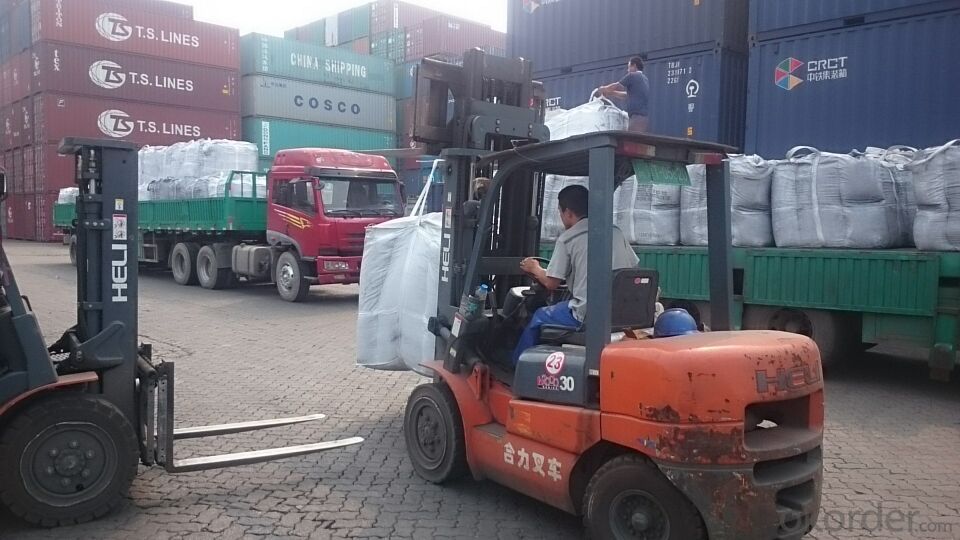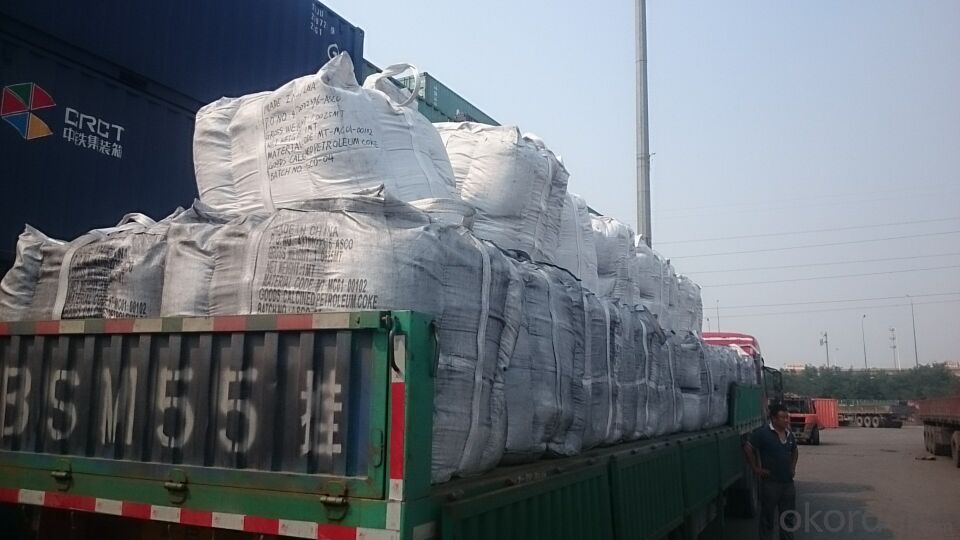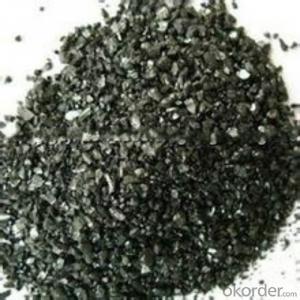GPC with lower Sulphur0.03% max in 0.5% H2O
- Loading Port:
- Tianjin
- Payment Terms:
- TT OR LC
- Min Order Qty:
- 24 m.t.
- Supply Capability:
- 5005 m.t./month
OKorder Service Pledge
OKorder Financial Service
You Might Also Like
Introduction:
GPC has good characteristics with low ash, low resistivity, low sulphur, high carbon and high density. It is the best material for high quality carbon products. It is used as carbon additive in steel industry or fuel.
Features:
1.Our strong team provide you reliable service that make you feel purchasing is more easierit is playing more and more important role in the industry
2. We ensure that we can supply capability with competitive price.
3. Work strictly to guarantee product quality,
4. Highest standard of integrity. Guarantee customer's benefit.
5. Supplying Pet Coke, Met coke, Foundry Coke, Carbon Raiser etc.it is playing more and more important role in the industry
Specifications:
F.C.% | 95MIN | 94MIN | 93MIN | 92MIN | 90MIN | 85MIN | 84MIN |
ASH % | 4MAX | 5MAX | 6 MAX | 6.5MAX | 8.5MAX | 12MAX | 13MAX |
V.M.% | 1 MAX | 1MAX | 1.0MAX | 1.5MAX | 1.5MAX | 3 MAX | 3 MAX |
SULFUR % | 0.3MAX | 0.3MAX | 0.3MAX | 0.35MAX | 0.35MAX | 0.5MAX | 0.5MAX |
MOISTURE % | 0.5MAX | 0.5MAX | 0.5MAX | 0.5MAX | 0.5MAX | 1MAX | 1MAX |
Pictures



FAQ:
1. Your specification is not very suitable for us.
Please offer us specific indicators by TM or email. We will give you feedback as soon as possible.
2. When can I get the price?
We usually quote within 24 hours after getting your detailed requirements, like size, quantity etc. .
If it is an urgent order, you can call us directly.
3. Do you provide samples?
Yes, samples are available for you to check our quality.
Samples delivery time will be about 3-10 days.
5. What is your terms of delivery?
We accept FOB, CFR, CIF, EXW, etc. You can choose the most convenient way for you. Besides that,
we can also shipping by Air and Express.
6. Product packaging?
We are packed in bulk ship or in ton bag or placing in container or according to your requirements.
7. Notice
please note that the price on Alibaba is a rough price. The actual price will depends on raw materials, exchange rate wage and your order quantity .Hope to cooperation with you, thanks !
- Q:How is carbon used in the production of paints?
- Carbon is used in the production of paints in several ways. One of the main uses of carbon in paint production is as a pigment. Carbon black, which is a form of elemental carbon, is commonly used as a black pigment in various types of paints. It provides a deep and intense black color, as well as excellent light absorption properties, making it ideal for creating dark shades in paints. Carbon also plays a role in the formulation of certain types of paints, such as carbon-based coatings. These coatings are used in applications where resistance to heat, chemicals, and corrosion is required. Carbon-based coatings are often used in industries like automotive, aerospace, and marine, where durability and protection are crucial. These coatings can be applied to various surfaces, providing a high level of protection and extending the lifespan of the painted object. In addition, carbon is used as a filler material in some types of paints. Carbon fillers are added to improve the mechanical properties of the paint, such as its strength, hardness, and resistance to wear and tear. Carbon fillers also enhance the overall performance of the paint, making it more durable and long-lasting. Overall, carbon is an essential ingredient in the production of paints, serving as a pigment, a component of coatings, and a filler material. Its versatile properties make it a valuable addition to various paint formulations, enhancing the aesthetic appeal, durability, and performance of the final product.
- Q:What is the role of carbon in respiration?
- Carbon plays a crucial role in respiration as it is a key component of organic molecules such as glucose. During respiration, glucose is broken down in the presence of oxygen to produce energy in the form of ATP. The carbon atoms in glucose are oxidized, releasing electrons that are ultimately transferred to oxygen, forming carbon dioxide (CO2) as a byproduct. This process, known as cellular respiration, occurs in all living organisms and is essential for the production of energy needed for various cellular processes. Without carbon, respiration would not be possible, and the energy required for growth, movement, and other life-sustaining activities would not be generated. Furthermore, the carbon dioxide produced during respiration is released into the atmosphere and serves as a crucial component of the carbon cycle, contributing to the regulation of Earth's climate and the growth of plants through photosynthesis.
- Q:How is activated carbon produced?
- Activated carbon is created by a process known as activation, which involves heating carbon-rich materials (such as wood, coal, or coconut shells) at high temperatures without oxygen. Activation can be done in two main ways: physically or chemically. In physical activation, the carbon-rich material is first carbonized by heating it to a high temperature. This creates a char with a high carbon content. Then, an oxidizing gas (like steam or carbon dioxide) is used to treat the char at temperatures ranging from 600 to 900 degrees Celsius. This causes the char to expand and develop a porous structure. The resulting material is washed and dried to eliminate any impurities, resulting in activated carbon. On the other hand, chemical activation involves saturating the carbon-rich material with a chemical activating agent (such as phosphoric acid, zinc chloride, or potassium hydroxide). The impregnated material is then heated to temperatures between 400 and 800 degrees Celsius. This process chemically reacts with the carbon, forming a porous structure. The activated carbon is washed and dried to remove any remaining chemicals. Both physical and chemical activation methods yield activated carbon with a large surface area and a network of pores. These pores enhance the adsorption capacity of the activated carbon, enabling it to effectively capture and eliminate impurities, contaminants, and pollutants from gases and liquids.
- Q:How does carbon contribute to the color of gemstones?
- Gemstone color is influenced by carbon, a vital element. Carbon's presence in a gemstone's crystal lattice structure allows it to absorb specific light wavelengths and reflect others, resulting in its distinct color. The arrangement of carbon atoms within the gemstone's structure can excite electrons, leading to the absorption of certain colors of light. This absorption process determines the gemstone's color, as the remaining wavelengths are reflected back to our eyes. For instance, diamonds can exhibit color variations, ranging from colorless to yellow or even fancy shades like blue or pink, due to the presence of nitrogen impurities. Similarly, in gemstones like rubies and sapphires, traces of carbon produce a spectrum of colors, spanning from red to blue, depending on the concentration and arrangement of these carbon impurities. Thus, carbon plays a vital role in the color and visual appeal of diverse gemstones.
- Q:How is carbon formed in stars?
- Carbon is formed in stars through a process called stellar nucleosynthesis, specifically in the later stages of a star's life. This occurs when helium nuclei (alpha particles) fuse together under high temperatures and pressures to form carbon nuclei.
- Q:What are the health effects of carbon monoxide poisoning?
- The human body can experience serious health effects due to carbon monoxide poisoning. When carbon monoxide (CO) is inhaled, it quickly enters the bloodstream and attaches itself to hemoglobin, which is responsible for carrying oxygen in red blood cells. As a result, the blood's ability to transport oxygen throughout the body is reduced, causing oxygen deprivation known as tissue hypoxia. The symptoms of carbon monoxide poisoning can vary depending on the level and duration of exposure. Common symptoms include headache, dizziness, nausea, confusion, weakness, and shortness of breath. These symptoms can easily be mistaken for other illnesses, making carbon monoxide poisoning particularly dangerous as it can go undetected until it reaches critical levels. In severe cases, carbon monoxide poisoning can lead to loss of consciousness, seizures, coma, and even death. Prolonged or repeated exposure to lower levels of carbon monoxide can also result in long-term health problems, including memory issues, difficulty concentrating, mood changes, and cardiovascular complications like heart disease. Certain populations, such as young children, pregnant women, the elderly, and individuals with pre-existing heart or lung conditions, are more vulnerable to the effects of carbon monoxide poisoning. Additionally, being exposed to high levels of carbon monoxide in enclosed spaces like homes with faulty heating systems or car garages can pose a significant risk. To prevent carbon monoxide poisoning, it is crucial to ensure proper ventilation in living spaces and regularly maintain fuel-burning appliances like furnaces, water heaters, and stoves. Installing carbon monoxide detectors in homes is also highly recommended as they can provide early warnings of dangerous gas levels. If carbon monoxide poisoning is suspected, immediate action should be taken to remove oneself from the source of exposure and seek medical attention. Medical professionals may administer oxygen therapy to increase blood oxygen levels and aid in the removal of carbon monoxide from the body. In conclusion, carbon monoxide poisoning can have severe health effects, ranging from mild symptoms to life-threatening conditions. Being aware, taking preventive measures, and responding promptly are crucial in safeguarding individuals from the dangers of carbon monoxide exposure.
- Q:RT~ I remember our teacher said, but I forgot all of a sudden......Ask for advice!
- Such as esterification can be generated, as well as aldehydes oxidized into ketones, can produce carbonyl
- Q:How does carbon affect the quality of soil?
- Carbon plays a crucial role in improving the quality of soil. It enhances soil fertility by serving as a food source for beneficial microbes and earthworms, which aid in breaking down organic matter and releasing essential nutrients. Additionally, carbon improves soil structure and water-holding capacity, promoting better root growth and reducing erosion. Overall, the presence of carbon in soil is vital for its health and productivity.
- Q:How does carbon impact the prevalence of heatwaves?
- Carbon impacts the prevalence of heatwaves by contributing to the greenhouse effect. When carbon dioxide and other greenhouse gases are released into the atmosphere, they trap heat from the sun, leading to a rise in global temperatures. This increase in temperature makes heatwaves more frequent, intense, and longer-lasting, posing significant risks to human health, ecosystems, and infrastructure.
1. Manufacturer Overview |
|
|---|---|
| Location | |
| Year Established | |
| Annual Output Value | |
| Main Markets | |
| Company Certifications | |
2. Manufacturer Certificates |
|
|---|---|
| a) Certification Name | |
| Range | |
| Reference | |
| Validity Period | |
3. Manufacturer Capability |
|
|---|---|
| a)Trade Capacity | |
| Nearest Port | |
| Export Percentage | |
| No.of Employees in Trade Department | |
| Language Spoken: | |
| b)Factory Information | |
| Factory Size: | |
| No. of Production Lines | |
| Contract Manufacturing | |
| Product Price Range | |
Send your message to us
GPC with lower Sulphur0.03% max in 0.5% H2O
- Loading Port:
- Tianjin
- Payment Terms:
- TT OR LC
- Min Order Qty:
- 24 m.t.
- Supply Capability:
- 5005 m.t./month
OKorder Service Pledge
OKorder Financial Service
Similar products
New products
Hot products





























